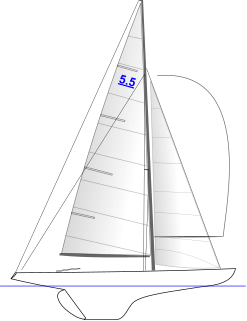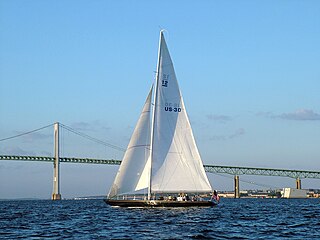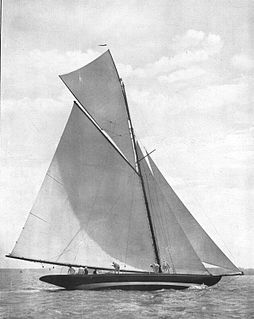
Area is the quantity that expresses the extent of a two-dimensional figure or shape or planar lamina, in the plane. Surface area is its analog on the two-dimensional surface of a three-dimensional object. Area can be understood as the amount of material with a given thickness that would be necessary to fashion a model of the shape, or the amount of paint necessary to cover the surface with a single coat. It is the two-dimensional analog of the length of a curve or the volume of a solid.

The horizon is the apparent line that separates earth from sky, the line that divides all viewing directions based on whether it intersects the Earth's surface or not. The true horizon is actually a theoretical line, which can only be observed when it lies on the sea surface. At many locations, this line is obscured by land, trees, buildings, mountains, etc., and the resulting intersection of earth and sky is called the visible horizon. When looking at a sea from a shore, the part of the sea closest to the horizon is called the offing.

Abraham de Moivre was a French mathematician known for de Moivre's formula, a formula that links complex numbers and trigonometry, and for his work on the normal distribution and probability theory.

In mathematics, Stirling's approximation is an approximation for factorials. It is a good approximation, leading to accurate results even for small values of n. It is named after James Stirling, though it was first stated by Abraham de Moivre.

The International 5.5 Metre class was created to yield a racing keel boat giving a sailing experience similar to that of the International 6 Metre Class, but at a lower cost.

The 12 Metre class is a rating class for racing sailboats that are designed to the International rule. It enables fair competition between boats that rate in the class whilst retaining the freedom to experiment with the details of their designs. The designation "12 Metre" does not refer to any single measurement on the boat, and is not referencing the vessels overall length, rather, measures the sum of the components directed by the formula which governs design and construction parameters. Typically 12 Metre class boats range from 65 to 75 feet in length overall; they are most often sloop-rigged, with masts roughly 85 feet tall.
The Universal Rule determined a yacht's eligibility to race in the America's Cup from 1914 to 1937 and for this the J-class was chosen. Boats built according to the rule reached their peak in the large J-class yachts. This Rating Rule is intended to calculate a rating for yachts, which can then be used to calculate its Time Correction Factor (T.C.F.) in order to have disparate yachts racing against each other. The first boat said to be built under the universal rule was Herreshoff's Doris built in 1905.

The International rule, also known as the Metre rule, was created for the measuring and rating of yachts to allow different designs of yacht to race together under a handicap system. Prior to the ratification of the International rule in 1907, countries raced yachts under their own national rules and international competition was always subject to various forms of subjective handicapping.
A set of equations describe the resultant trajectories when objects move owing to a constant gravitational force under normal Earth-bound conditions. For example, Newton's law of universal gravitation simplifies to F = mg, where m is the mass of the body. This assumption is reasonable for objects falling to earth over the relatively short vertical distances of our everyday experience, but is untrue over larger distances, such as spacecraft trajectories.

The One Ton Cup is a trophy presented to the winner of a sailing competition created in 1899 by the Cercle de la voile de Paris (CVP).

The International Six Metre class is a class of classic racing yachts. Sixes are a construction class, meaning that the boats are not identical but are all designed to meet specific measurement formula, in this case International rule. At their heyday, Sixes were the most important international yacht racing class, and they are still raced around the world. "Six metre" in class name does not, somewhat confusingly, refer to length of the boat, but product of the formula; 6mR boats are, on average, 10–11 metres long.
The Matthews correlation coefficient (MCC) or phi coefficient is used in machine learning as a measure of the quality of binary (two-class) classifications, introduced by biochemist Brian W. Matthews in 1975. The MCC is defined identically to Pearson's phi coefficient, introduced by Karl Pearson, also known as the Yule phi coefficient from its introduction by Udny Yule in 1912. Despite these antecedents which predate Matthews's use by several decades, the term MCC is widely used in the field of bioinformatics and machine learning.

The International Eight Metre class are class of racing yachts. Eight Metre boats are a construction class, meaning that the boats are not identical but are all designed to meet specific measurement formula, in this case International rule. Before WW II Eights were the most prestigious international yacht racing class, and they are still raced around the world. "Eight metre" in class name does not, somewhat confusingly, refer to length of the boat, but product of the formula. 8mR boats are on average some 15 metres long. Between 1907 and 2008 approximately 500 8mR boats were built, 177 of them have survived until today.
The 8 Metre was a sailing event on the Sailing at the 1924 Summer Olympics program in Le Havre. A program of matches and semi-finals were scheduled. In case of a tie sail-off's could be held. 25 sailors, on 5 boats from 5 nations competed. A sixth entry from Italy did not show.
Ton classes are categories used to identify classes of yachts.

The International Six point Five Metre Class is a construction class, meaning that the boats are not identical but are all designed to meet specific measurement formula, in this case the French rule called Jauge chemin de fer.

The International Seven Metre Class is a construction class, meaning that the boats are not identical but are all designed to meet specific measurement formula, in this case International Rule. At their heyday, Metre Classes were the most important group of international yacht racing classes, and they are still actively raced around the world. "Seven" in class name does not, somewhat confusingly, refer to length of the boat, but product of the formula; 7mR boats are, on average, 13 meters long.

The International Ten Metre Class is a construction class, meaning that the boats are not identical but are all designed to meet specific measurement formula, in this case International Rule. At their heyday, Metre Classes were the most important group of international yacht racing classes, and they are still actively raced around the world. "Ten" in class name does not, somewhat confusingly, refer to length of the boat, but product of the formula; 10mR boats are, on average, 16.5 meters long.
The International Nine Metre Class is a construction class, meaning that the boats are not identical but are all designed to meet specific measurement formula, in this case International Rule. At their heyday, Metre Classes were the most important group of international yacht racing classes, and they are still actively raced around the world. "Nine" in the class name does not, somewhat confusingly, refer to the length of the boat, but the product of the formula; 9mR boats are, on average, 18 meters long.

The IYRU Fifteen Metre class yachts are constructed to the First International rule of 1907. A total of twenty 15mR yachts were built between 1907 and 1917, the four that have survived are still actively raced.














